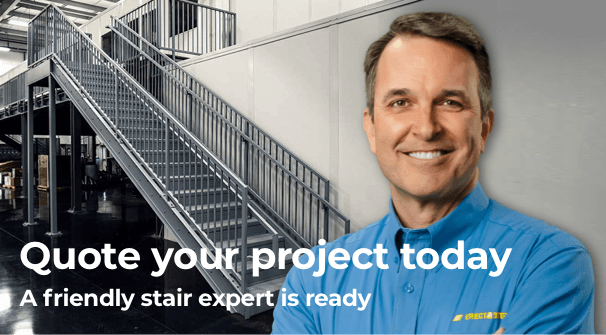Get a quote, configure a custom stair or ask a question. We're here to help!
Gulfstream keeps maintenance crew safe with these aviation stairs
View All AeroSpace InstallationsRolling maintenance work platforms are at the core of keeping Gulfstream business jets in tiptop shape
Gulfstream is one of the world’s leading manufacturers of private jets. The company was founded in 1958 and has since delivered over 2,800 aircraft to customers around the globe. Gulfstream offers a wide range of jets, including the Gulfstream G650™, the world’s fastest long-range business jet. The company is headquartered in Savannah, Georgia, and has facilities in the United States, Europe, and Asia. In the Top 10 Private Jets with the Best Range list, Gulfstream gained four spots, signifying that the company had built a solid reputation in the business aircraft segment.
The Gulfstream G700™, their newest and biggest aircraft, was unveiled in 2019. This state-of-the-art private jet will include Rolls-Royce Pearl 700 engines, new Gulfstream winglets, and a huge interior with up to five living quarters, with a range of 7,500nm. According to the manufacturer – “The G700™ delivers the most spacious, innovative and flexible cabin in the industry, plus all-new, high-thrust Rolls-Royce engines and the award-winning Symmetry Flight Deck™.”
With a strong commitment to safety, Gulfstream seeks to provide its customers with the highest quality and service and vows to shape the future of business aviation built on next-generation technology, specialized to keep pace with their customers’ changing needs.
That’s why, when it comes to choosing a manufacturer for the rolling ladders and work platforms their workers use, Gulfstream only has the affinity for the best. Rolling platforms and ladders are essential to maintenance and manufacturing, and Gulfstream knows that only the best partner will fit the bill.
Keeping Aircraft Maintenance Workers Safe
Aircraft manufacturing and maintenance involve various tasks workers must perform to keep an aircraft in good working condition. Some jobs, such as cleaning and inspecting engines, are done while the business jet is on the ground. However, other duties, such as painting or repairs, require workers to be at certain heights to access even the top of the aircraft fuselage.
Working at heights can be dangerous, with several risks to consider. Perhaps the most obvious is the danger of falling off an elevated platform or workstation. However, there are other risks as well, such as falling through a hole in the floor or walls, slipping on unstable or wet ground, or falling due to failed safety equipment. Any of these accidents can result in serious injury or even death. That’s why it’s noteworthy to take precautions when working at heights, such as using safety harnesses and following all OSHA guidelines.
Accessing heights can be done using various methods, but awareness of fall protection protocols is one of the most common approaches to avert fall injuries. Fall protection can involve using a harness and tether to secure oneself to the aircraft, deterring employees from sustaining physical injuries. While fall protection is essential to aircraft maintenance, many human factors can lead to fall injuries. One of the most common is poor judgment when deciding whether or not to use fall protection. Other human factors that can contribute to falling injuries include fatigue, distraction, and inexperience. By understanding these human factors, workers can take steps to reduce the risk of fall injuries during aircraft maintenance.
What Role Do Human Factors Play in Servicing Aviation Equipment?
Understanding possible human mistakes can oblige your team to improve their performance and safety. The following are some of the most prevalent human elements in airplane maintenance and service:
Teamwork: Interaction can take the form of anything as simple as handing off work while switching shifts. Maintenance workers may assist one another by documenting difficulties and speaking out when necessary.
Exhaustion: According to research by the Federal Aviation Association, maintenance staff sleeps an average of 5 hours every night. That’s three hours fewer than the usual limit, which might negatively impact work productivity.
Disruptions: Distractions might range from ringing mobile phones to the unfettered entry of uninvited visitors. This human aspect is a catch-all for everything extraneous or interfering with the safety procedure.
Access to resources: Your crew requires aviation maintenance & repair training to accomplish the best job possible. Because there is a tremendous need for labor, this requirement might become buried in the daily hustle and bustle of the job. More resources may also imply additional inspection teams to assure high-quality work.
Tension and physical stress: Finding and retaining skilled workers in a specialized sector may be difficult, and smaller teams might put more strain on individuals.
Leniency: Employees working in the same role for a significant amount of time may develop a sense of complacency, leading them to disregard proper safety procedures.
Lack of training or knowledge: Employees must manage a large amount of information with each task. The acquired knowledge can escape any worker’s mind when there are hundreds of pages of work cards and publications to follow for each job.
Aviation maintenance is a critical part of ensuring the safety of both pilots and passengers. The Aircraft Maintenance Technician (AMT) is responsible for the upkeep of the aircraft and must be able to identify and correct any problems. While AMTs are highly trained and skilled professionals, they are also human and can make mistakes. Human factors in aviation maintenance refer to the study of how humans interact with systems and equipment. It takes into account both the physical and psychological factors that can affect worker performance. By understanding these factors, safety managers can take steps to prevent errors and ensure worker safety. Aircraft manufacturers can implement measures that include better training, clearer documentation, and improved equipment. With better insight into human factors, the aviation industry can continue to improve safety for everyone involved.
Preventative maintenance is critical to keeping an aircraft in good working condition. By performing these repair and maintenance tasks on a regular basis, it is possible to prevent many potential issues from developing into serious problems. Essentially, preventative maintenance covers any work performed from a list of permitted tasks to replace small standard parts or service parts of the aircraft without taking much apart. Some common preventative maintenance tasks include checking and servicing the engine, checking the landing gear, and inspecting the wings and control surfaces. Periodically completing these tasks makes it possible to keep the aircraft in good condition and prevent more serious issues from developing.
Why Do Aircraft Manufacturers Choose Rollastep?
It’s not only Gulfstream; Boeing prides itself on having mobile rolling platforms at its San Francisco facility. At RollaStep, we understand that meeting customer needs is always the top priority. That’s why we’ve invested in technology that allows us to serve our customers better and why we’re always searching for ways to improve. Our team has centuries of combined industry experience, and we use that knowledge to build solutions that make a difference. We’re never satisfied with the status quo and always looking for ways to exceed our customers’ expectations. Whether investing in new technology or finding new ways to improve our products and services, we’re dedicated to providing the best possible experience for our customers.
Aircraft maintenance workers need durable rolling platforms to help them complete their work safely and efficiently. These platforms provide a stable surface for workers to stand on while they carry out their tasks, and they can be easily moved around the aircraft as needed. In addition, the aluminum work platforms come with necessary features like safety guardrails and handrails that prevent workers from falling off. Aircraft manufacturers are responsible for ensuring that these platforms are well-maintained and safe for workers to use. By investing in quality rolling platforms, aircraft manufacturers can help to protect the well-being of those who keep their aircraft and its passengers safe.










